Skateboard Ledge
A Skateboard ledge is a corner to slide on. Anything from a curb, planter, hubba or a box. They are easier to skate than a rail because there is only one edge to balance on. Plus you can't fall over the other side if you miss landing on the edge.
This will boost your confidence a lot and allow you to try riskier tricks with less chance of getting hurt.
Types of Skateboard Ledges
The ones you find in the street vary from concrete to metal or stone. They can be pretty much anything that you can ollie to and slide on.
Flat
A straight flat ledge is all you need. If you get bored then try learning a different trick. There are hundreds of them.
Angled
That is when the ledge is higher on one end than the other. It is fun to grind up and off or down with speed. Keep the angle subtle to increase difficulty going up and and an easy slide going down. Keep the angle change low. You want skaters to be able to do a good amount of tricks. Lower than 10° and you should be good to go.
Hubba
A hubba ledge is a shape modeled after the famous San Francisco Spot Hubba Hideout. It is a down ledge that starts at the top of stairs and ends at a lower level than the starting.
Curved
Some subtle curves can be fun and add a new dimension to your tricks. Keep the total angle pretty low. If you make it too tight then the ledge will not be skateable. Keep it mellow and it will work out a lot better.
Kinked
Kinks or changes in vertical angle if you use them need to be subtle. Make a change in angle no greater than 15°. Anything higher than that is not that skateable. Also be sure to put at least 48" or a board length between kinks.
Ideal Size of a Skateboard Ledge
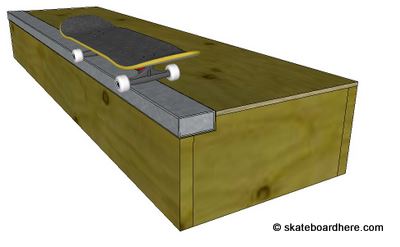
Height
Ledges should be 9"-18" high. Anything lower and your ollie is stunted and you can’t do proper tricks. Anything higher makes it harder to skate. Unless you want to be sponsored or pro don't bother with this.
I prefer around 12"-15" in height. That lets me decide the difficulty by trying tougher tricks and trick combinations. Increasing difficulty by adding height isn't for me. I like learning more and more tricks on a lower ledge. The increased difficulty of tricks is what motivates me.
I do the tricks I like in the skatepark of home ledge. I then take that confidence to the streets where the height and size could be anything.
Length
A good grind and slide should be at least a few feet long. I would say 3' is a good length to aim for. If you add speed then you might want to crank that up to 5' or more feet.
This is because you don't usually land right on the beginning of the ledge. You will need to make it long enough to land on and have a decent slide. Make the rail at least 6' long or. I have learned this from experience that 6' to 8' is better.
If you can make the skateboard ledge 8' long, that will give you plenty of room to get your shred on.
Make the top of the skateboard ledge deep enough that you get confidence skating it. 3' or more is good. At that width you can also do manual trick on it too.
Width
A good width is 3' or over. This gives you a lot of deck to land on without the feeling that you will fall over the over side. That gives you confidence and allows you to push your tricks farther. An added bonus is that the ledge will be wide enough to a manual pad too.
What is Good to Grind On?
The edge that you land on makes a big difference in how the skateboard ledge feels. There are a few different options and each gives you a feel all its own.
Metal
There are a few different ways to make a metal edge for skateboarding
Square
The cheapest way to make a grind edge is using an angle iron. Using a steel angle on the corner of your ledge is one of the simplest ways to make the edge. There are some disadvantages though.
The corner edge is sharp. This can cause injury if you fall on it. The sharp edge is a sticky corner. It can wear your truck and your deck down by digging a groove into them.
The grind on a sharp corner feels a little rough. It makes a good edge for cheap projects and the short term but isn't recommended.
Rounded
The fillet or rounding on the edge of structural steel squares and rectangle feels good to grind.
The radius can vary but the feeling is usually the same. a smooth grind and holds wax well. Attaching the tubes will take a few steps, steps that are well worth the effort.
Flush
Having the edge flush with the top and sides of the rest of the ledge.
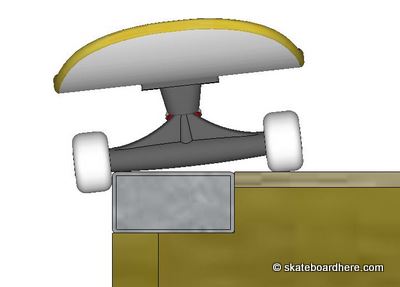
Bumped
Raising the edge for a reveal gives you something to lock your skateboard onto. It can lock in better for a grind and have better pop from a slide.
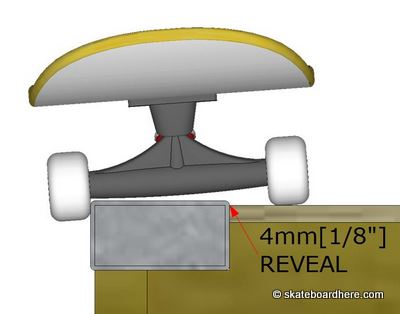
Thick Plate
A thick plate with a rounded top edge along the side of the ledge. Concrete is poured and finished smooth along the top. This looks like granite, grinds like ice, is the easiest to form up and build, and will be very durable.
The thickness and shape of the plate make it great to lock into. The thick profile of the metal makes it very durable and I expect it will last longer than the other options.
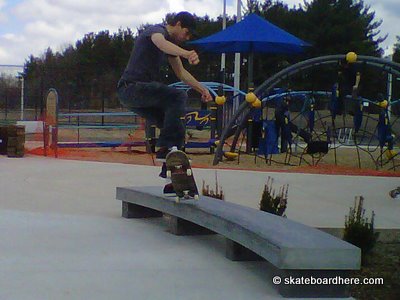
Concrete
The feel of grinding concrete inspires!
Thrash, Shred, Grind!
The stones in the concrete mix give a great rough feel and sound when grinding. For the feeling of raw power it cannot be matched.
Concrete is so often seen and skated in the streets. It works awesome with the right amount of wax or existing paint. The edge will wear down into a rounded profile that can be great to skate.
In the streets a spot will get skated less than in a skatepark. So they last a lot longer. The wear on concrete ledges in a skatepark is high and they often don't last long and need replacement.
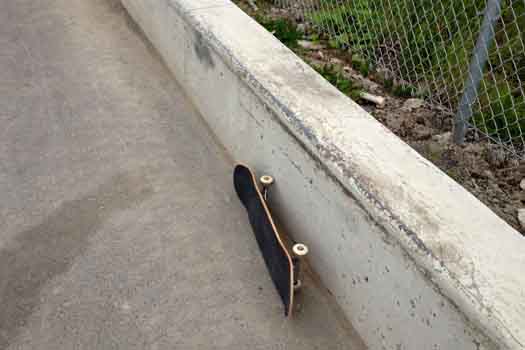
Stone
To some street skaters stone ledges are the holy grail of skateboarding.
Think about the downtown of any city. The high-rises have awesome plazas filled with stone ledges. Stone also gives a good feel when grinding. It grinds smoother than concrete but not as icy as metal. When it grinds nice it grinds nice.
Most skaters call stone ledges marble. This is not quite right. Marble is too soft to stand up to skateboarding. Most stone ledges are made of granite which is much harder. Another hard stone is basalt.
Stone ledges are pricey but you need to use one continuous piece of stone for each grind. A joint will bump you off your grind and wear out much faster.
The added cost and shorter lifespan of a stone skateboard ledge doesn't pan out in my mind. If you are making a personal place to skate where the traffic won't be high then it might be worth thinking about. Otherwise, stick with metal.
Building a Skateboard Ledge
An ebook with ramp and rail plans, cut lists and cost estimates is coming. As skateboardhere gets bigger and better.
Return from Skateboard Ledge to Skateboard Ramps
Return from Skateboard Ledge to skateboardhere homepage